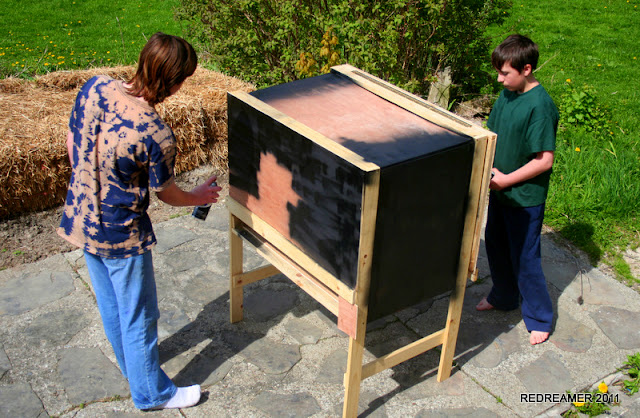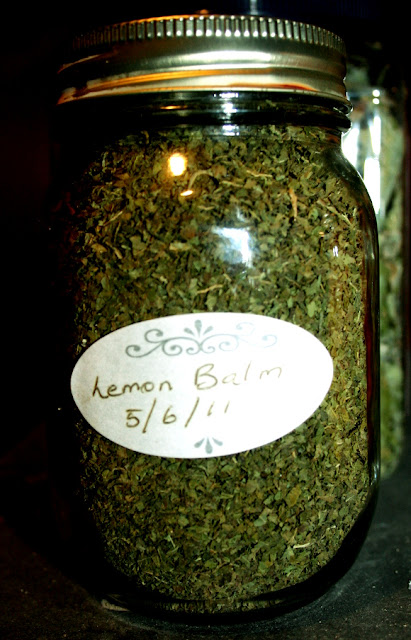Homeschooling Science and Language Arts Project for the term is to create a solar Dehydrator. We have an electric one but we need greater capacity and saw no reason to spend lot's of $$ when an effective efficient free dehydrator can be made at home with recycled materials. So far everything we needed to use has been recycled from our stored bits and pieces.
This video was part of the inspiration to create our own solar dehydrator... originally our plan was to make the heat box element as a portable extra heat source for the chickens during winter and our idea evolved from that. Essentially we are making a larger heating box than the one in the video... we can use it for dehydrating in summer and heating a spot area in winter... It is designed to also fit over the bulkhead doors into the cellar and can be used to heat the front mudroom which is currently unheated Even raising the temperature 20f will extend our growing season. Well that is the plan.
We collected soda cans over winter and the project got a real kick start when Patrick brought home a rear projection television for the boys to take apart for the Fresnel lens.... and realized that we also had a large sheet of polycarbonate salvaged from that project too. So we began by grinding off the bottoms of the cans using a belt sander upside down on a bench (we put screws into the bench to secure it from moving forwards). It was noisy to sand aluminium cans but otherwise with safety glasses it worked well.
Sanding the cans to remove the bottom using a medium grit sandpaper.
Taking any sharp bits off the cut edge with a Dremel.
More to come as we progress. Why don't you have a think about doing something similar yourself?
PART TWO.
Half way there making the tubes out of the cans. Ours measured 8 cans per tube and we made 12 tubes..... and we ended up only needing 11 because we forgot in our estimating to allow for the intrusion of the wooden frame INSIDE the outer edge of the polycarbonate sheeting. So 88 cans in total for the whole project... collected slowly over winter... total cost.... well less than $5 if we had returned them for recycling.
Drew putting on the back of the box..... cut to the same size we reused some old plywood paneling,
Jye hammering the small nails onto the back to attach the plywood to the frame it took a bit of concentration and the nails were small.
Drew adding nails to the back too. Pretty deft with the hammer.
Here the boys are using hand files to take off any burrs left behind after cutting out the holes with the hole saw. Cutting out the holes with a cordless (WITH a fully charged battery) took a little while but we measured out the spacing and cut them out... going through BOTH fully charged batteries to do the 11 holes. It would have been better to do it using a corded drill ... but the only one we have would risk wrist wrenching its a little too powerful for the job and hole saw bits can grab unexpectedly so it was a trade off of speed for safety.
We took it outside even though it was too cold for the paint to dry .... just for the application and because of fumes. We left it to get tacky dry then moved it under the back veranda roof in case it rained.
Next Step is to add the polycarbonate cover and the base plate....which means another 11 holes to drill tomorrow which will be the last major task..... we had to wait for drills to recharge but all in all it was a productive day. The cold damp weather is making drying of glue a little longer than might have been usual.... today it was 33f ALL DAY.
and today we added the polycarbonate top and the dehydrator cabinet frame.
We are VERY VERY happy with this result....... Now to build the cabinet for the dehydrating.... Stay tuned.
PART THREE
With $12 worth of pine timber we set about constructing the Cabinet for the dehydrator.
So far this is what we have. Using the width of the heat box as the starting dimension we just decided on a height and width that used the timber with as little waste as we could.
PART FOUR
One of the first things we needed to do was as a science/mathematics home school project was measure the panel sizes to cover the framework.
We used 3 ply panelling we had left over from building the chicken house in the barn..... set up the jig saw and two cordless drills. One as a screw driver and one to drill holes. First job before cladding the framework was to put the shelf supports in so we could manoeuvre the drill without any restrictions from the outside walls. We actually used tomato stakes cut up for the job at two foot lengths.
Originally i had 5 square foot of dehydrating space in my electric dehydrator. I now have 42 square feet of drying space. No comparison... and if you grow a garden and dehydrate you KNOW that is a very small volume for when the crops are in. Therefore instead of spending a great deal of money and the ongoing cost of electricity to power it.. i thought it a good opportunity to invest time into a way to dehydrate that would be far more sustainable in the long term.
Not only that but we have also no running costs.
No electrical power needed to run this low tech way of preserving food.
Tomorrow's task is to make the back doorway and we have decided that we would be better off purchasing a piano hinge to take advantage of the large opening without being concerned with limitations to access.
Photo's to follow.
Btw we bought tomato stakes to use as shelf supports/shelf framework and total cost so far is $30.
PART FIVE
Today the last job of all to wrap up the making the Solar Dehydrator is to make the shelving. We actually are using tomato stakes for the frames after a sanding down to remove any roughness in the wood and slightly bevel the corners for smoother gliding....
PART SIX
So last job we did was make the box waterproof.... and while we only got a very thin layer of paint on since we ran out... it will help protect the wood until we get some more today. We also considered that painting it black would add to it's thermal quality and make it slightly hotter inside...
Relocated it off the veranda into it's place of function next to the kitchen garden... we wanted it to have the ability to be moveable as the sun moves when in use. We have catnip drying inside at the moment as a first trial.
Today we hit a new Maximum temperature inside the unit... :) and are still deciding if we need to add a fan to move the air around.... to even out the temperatures inside. Of course it will be solar powered. We have the panel.... we just have to locate where we put the fan...
and the first produce we used it for was lemon balm tea and some catnip.... dried up ready to store for the rest of the year.
I also discovered that the aluminium cookie sheets fit PERFECTLY into the screen shelves to double up for drying egg or any other liquid type produce... (i am thinking fruit leather)
We added some extra bits to the roof to make the inside unable to leak since the last few days have been very wet..... this allows the inside to stay much dryer.
Please leave a comment or question and I will do my best to reply..... and consider making your OWN Solar Dehydrator.... the solar heating panel is can be used to provide heated air to supplement the home/barn heating as it is completely removable from the dehydrator.































2 comments:
Hi Wendy,
I'm very interested in seeing your solar dehydrator project. Unfortunately most of the pictures are missing.
Diane
Diane i checked the post and resubmitted the missing photo's...... hope it helps.
Post a Comment